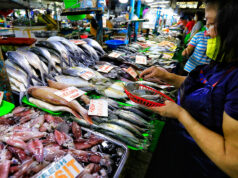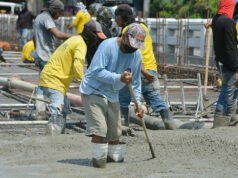Overall price increase in August slowest in 3 years
By Mark T. Amoguis
Senior Researcher
INFLATION clocked in at its slowest pace in three years in August amid a softer increase in food prices, particularly rice, the Philippine Statistics Authority (PSA) reported on Thursday.
The headline inflation rate — the general increase in prices of widely used goods and services — logged 1.7% in August, slower than 2.4% in July and 6.4% in August 2018. August’s reading matched the 1.7% logged in September 2016 and was the slowest in three years or since the 1.3% inflation rate posted in August 2016.
Last month’s inflation fell at the midpoint of the Bangko Sentral ng Pilipinas’ (BSP) 1.3-2.1% estimate. It was, however, lower than the 1.8% estimate median in BusinessWorld’s poll of 12 economists late last week.
Core inflation, which strips out commodities prone to volatile price swings, eased to 2.9% in August from 3.2% in July and 4.8% in August 2018.
Year to date, headline inflation clocked in at three percent, at the midpoint of the BSP’s 2-4% target range for 2019, albeit still above the central bank’s 2.6% forecast for the entire year.
In a mobile phone message to reporters, BSP Governor Benjamin E. Diokno described the latest headline inflation rate as “excellent news.”
“This gives us more confidence that average inflation would be in the neighborhood of 2% in Q3 before it would increase slightly in Q4,” Mr. Diokno explained.
“The Monetary Board will definitely take note of this positive development in its next policy meeting on Sept. 26.”
In a separate statement, the BSP cited “ample domestic food supply conditions along with lower global oil prices” as having contributed to the inflation downtrend.
It warned, however, that the “deepening trade tensions between China and the US along with ongoing geopolitical risks have raised global economic uncertainty which poses a downside risk to the inflation outlook.”
The PSA attributed the August slowdown primarily to the slower increase in prices of heavily weighted food and non-alcoholic beverages component at 0.6% from 1.9% in July and 8.5% in August 2018. Food and non-alcoholic beverages account for 38.3% of the theoretical basket of goods that an average Filipino consumes.
The PSA also noted slower annual rates in housing, water, electricity, gas and other fuels (1.8% from 2.2% in July); health (3.1% from 3.2%); recreation and culture (1.8% from 3.2%); and restaurant and miscellaneous goods and services (3.2% from 3.3%). Meanwhile, the transport commodity registered a decline at 0.2% from 0.7% the previous month.
The food-alone index likewise slowed to 0.3% versus the previous month’s 1.7% and 8.2% a year ago as slowdowns were noted in most food groups. In particular, rice — which accounts for 10% of the average household’s consumer basket — saw its annual rate decline further to 5.2% in August from a 2.9% contraction in July.
“Last year, we had a relatively high retail price for rice. If you’ll notice, the negative inflation [for rice] started four months back. There’s really a continuing drop in the actual price month on month because of the negative inflation in rice,” National Statistician and Civil Registrar General Claire Dennis S. Mapa said during the press briefing.
In a statement, National Economic and Development Authority (NEDA) Undersecretary for Policy and Planning and currently Officer-in-Charge (OIC) Rosemarie G. Edillon said that the law liberalizing rice imports that was signed into law six months ago “continues to help increase [the] rice supply in the country.”
The same statement from NEDA noted that the domestic retail and wholesale price of the staple is down by 10-13% or by P4.2-5.2 per kilogram compared to price levels last year.
For HSBC Global Research economist Noelan C. Arbis, the decline in food and oil prices “led to the moderation in prices.”
“Meanwhile, core inflation remains on a stable trend, with most components rising only moderately and within their historical trend. If this trend persists, headline inflation is likely fall even lower in months ahead (i.e., low 1%) due favorable base effects,” Mr. Arbis said in a separate research note.
For his part, Security Bank Corp. chief economist Robert Dan J. Roces said that the below-target inflation rate gives the BSP more room to continue its easing cycle.
“The Monetary Board will definitely take note of the latest CPI (consumer price index) data in its September 26 policy meeting with a high chance of a 25 bps (basis point) cut and continuing its easing cycle to reverse the heavy 175 bps hike in 2018,” Mr. Roces said in an e-mail.
JPMorgan Chase Bank NA Singapore Branch economist Nur Raisah Rasid noted the August print marks the first time since October 2016 that inflation has fallen below the lower bound of the BSP’s 2-4% target range.
“The slower overall CPI growth in the coming months amid a softer than expected pickup in domestic growth, in our view, likely opens the room for another cut in [fourth quarter of 2019],” Ms. Rasid said in a research note.
With inflation moving below the central bank’s target, ING NV Manila Branch senior economist Nicholas Antonio T. Mapa expects BSP’s Mr. Diokno “to deliver on his pledge and cut policy rates by an additional 25 bps” in their next policy meeting.
Mr. Mapa also expects the central bank to slash banks’ reserve requirement ratio (RRR) by 100 bps in the fourth quarter this year, saying that Mr. Diokno “has telegraphed his moves effectively” by indicating that decisions on the RRR will be announced on a quarterly basis.
“[W]e expect him to reduce [the] RRR in two tranches of 50 bps, possibly at the end of October and end of November,” Mr. Mapa said in a separate research note.
BSP’s Mr. Diokno signaled last month that the central bank will cut policy rates by 25 bps before the year ends.
The central bank has so far cut benchmark rates by a total of 50 bps this year, partially dialing back the 175 bps cumulative hikes triggered last year by successive multi-year-high inflation that peaked at a nine-year-high 6.7% in September and October. This brought the overnight deposit rate to 3.75%, overnight reverse repurchase rate to 4.25% and the overnight lending rate to 4.75%.
On the other hand, the RRR currently stands at 16% for big banks and six percent for thrift, savings and cooperative lenders following the phased 200-bp cut implemented after an off-cycle meeting last May. Mr. Diokno had said that the Monetary Board’s consensus is to “pre-announce” plans for the RRR on a quarterly basis.



